Guide d'achat des pompes de puits
1 décembre 2021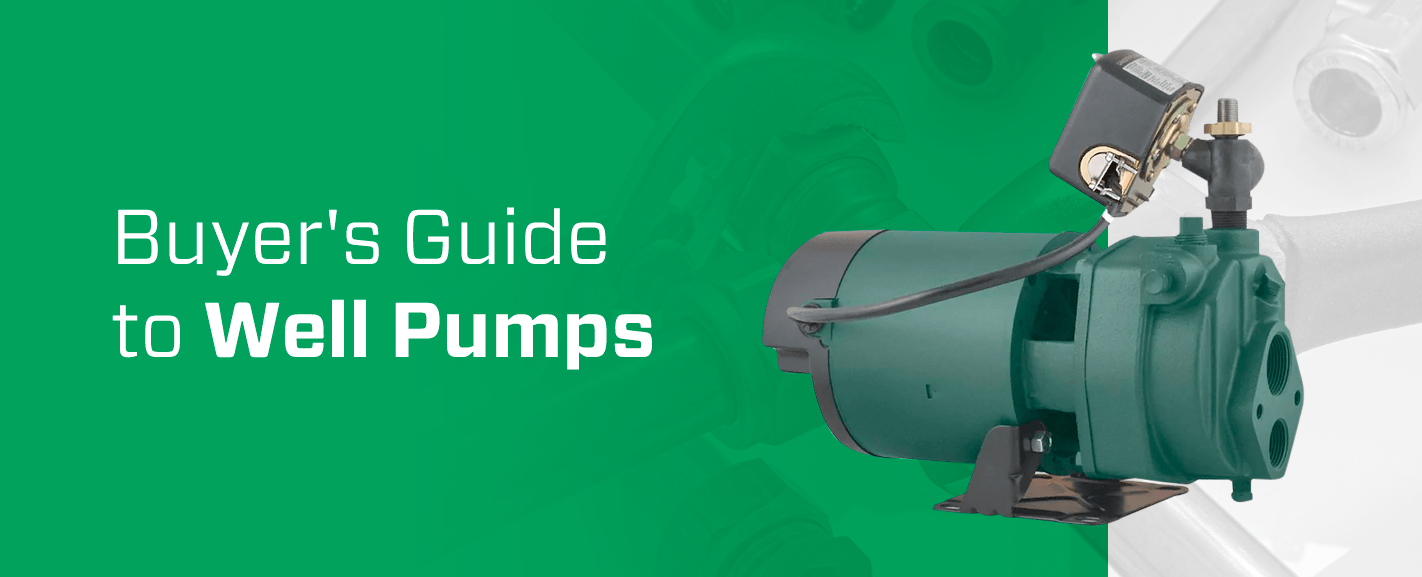
More than 13 million households in the United States rely on private wells to supply potable water for their living space. With an efficient, high-quality pompe de puits, you can pull the water you need from your underground well right to your sink, shower or appliance. If you need to replace this component of your property, it’s an easy project to do yourself, but it’s essential to consider the best product for your specific application.
To find a well pump that works for you, you’ll have to discover how much water you’ll need the pump to handle and what equipment can accommodate your new unit. The packaging for your desired product, along with this beginner’s guide to well pumps, should have everything you need to help you make your final decision.
What Is a Well Pump?
The purpose of a well pump is to control the flow of water in your private well, either through pulling it from above ground or pushing water from under the surface. Jet pumps are positioned above ground and draw water up from below, while submersible pumps push water upward from below to your home’s water fixtures.
How Does a Well Pump Work?
A well pump applies centrifugal force to propel water upward from an underground reservoir to supply your property with water. This unit’s prime refers to the water that fills the pump from the supply line to provide adequate suction. Depending on the configuration, a well pump may use any of the following components to function:
- Éjecteur: If you have a deep well, you’ll need to install an ejector inside the pump. This accessory creates a vacuum that allows you to draw up water from 25 to 110 feet deep.
- Clapet de pied : This piece connects to the end of the suction line and causes water to flow only upward. It has a strainer on it and controls prime and pressure when the pump isn’t in use. A malfunctioning foot valve reduces prime quality, resulting in pump failure.
- Clapet anti-retour : Instead of a foot valve, shallow jet and submersible well pumps have check valves built into them that allow you to monitor pressure and prevent backflow.
- Air pressure tank: Most well pumps mount onto an air pressure tank to store water and provide adequate pressure when the pump is idle. As you replace the well pump, you may want to inspect the air tank for wear and tear. If the air tank begins losing its quality, it can lower your pump’s pressure or cause it to run continually.
- Pressostat : This component works with the air pressure tank and controls electrical currents’ flow according to the system’s current pressure. For a jet pump, the typical pressure factory settings are 20/40 psi. The pressure switch will activate the electrical contacts when you use water in the house and turn it off when you’ve finished.
- Thermal and overload protection: Manufacturers incorporate thermal protection into shallow well jet pumps to guard against overheating in the motor that could result in pump failure. The motor could get too hot when overloaded or when an obstruction prevents the shaft from rotating.
- Booster: This component increases the pressure capacity in shallow well pumps so water pressure can stay consistent.
If you have to replace your well pump, consider replacing all of these components as well. Most of these pieces accommodate your specific product according to the model and manufacturer. By updating them, you also know that they’ll likely last as long as your brand-new well pump.
What Is a Well Pump Used For?
Well pumps are popular in areas with warmer weather conditions or high water tables. They’re useful for the following applications on a residential plot of land:
- Providing potable drinking, cleaning or bathing water from a well
- Controlling the water pressure within a home
- Supplying water for residential irrigation systems
- Powering an in-ground sprinkler system
- Emptying water out of a pool or other large containers
- Watering the plants and crops in a garden
- Providing hot water and heat into the home through a radiator
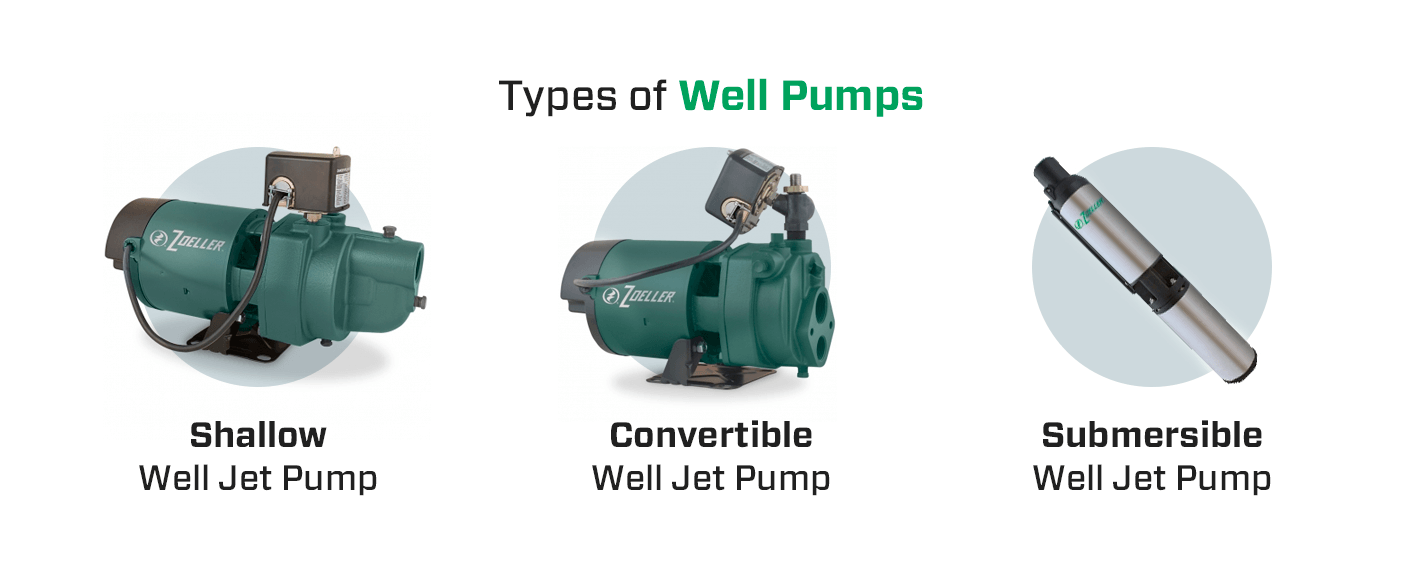
Types of Well Pumps
Consider the various characteristics of above-ground jet pumps and submersible well pumps to find the appropriate product for your application. Not sure where to start? Contactez un de nos experts ou trouver un détaillant près de chez vous to find the right well pump for your home.
1. Shallow Well Jet Pump
UN shallow well jet pump has one pipe on the front that draws water from a well at a maximum depth of 25 feet. It runs on electricity and mounts on top of pressure tanks. Instead of going underground, this pump configuration sits outside the well in special housing. The horsepower for a shallow well pump is typically 3/4 horsepower, carrying about 15 gallons of water per minute to your home. Since this unit is smaller than a convertible well jet pump, it tends to cost less.
2. Convertible Well Jet Pump
For deeper well applications, a convertible well jet pump draws water at a maximum depth of 110 feet using the two pipes from within the well. As a convertible configuration, it can also act as a shallow well jet pump. The horsepower for a convertible jet well pump is usually 1, offering a water flow of about 16 gallons per minute. Like a shallow well jet pump, this configuration goes in a well housing instead of going underground, mounting on top of a pressure tank.
You may want to replace your well pump with a convertible well jet pump if you need to:
- Draw water from a well that’s deeper than 25 feet.
- Take a large volume of water out of a swimming pool.
- Transport water from a tank on one side of a field to a water source on the other.
3. Submersible Pump
UN submersible pump pushes water from water underground at a maximum depth of 325 feet. This configuration pushes water upward through one pipe that usually connects to a pressure tank. You can install it below the ground a few inches above the well’s bottom. The pump cannot function unless it’s fully submerged underwater. The horsepower of a submersible pump is 1/2, 3/4 or 1. It can bring water up to a small- or medium-sized home at a rate of 26 gallons per minute.
When you turn on the pump, the motor activates the shaft and turns the impellers. As the impellers’ fins rotate, they force water upward and send it through the opening. The water travels through the well pipe up into the storage tank or other appliances.
Submersible pumps are available in two- and three-wire configurations. Consider which one can accommodate your property’s connectivity by looking for the controls of your existing unit. You’ll need a three-wire model if you have a control box inside your home, and a two-wire version if it’s not present.
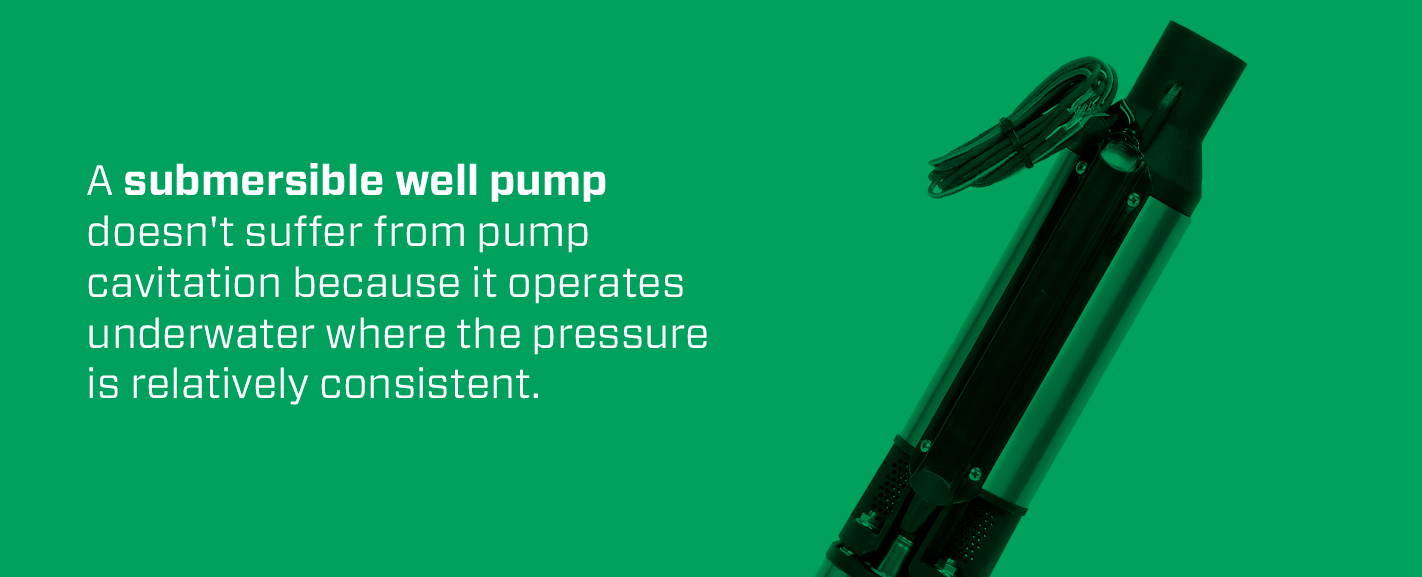
Benefits of Submersible vs. Jet Well Pumps
As you consider whether to invest in an above-ground jet well pump or a submersible one, keep in mind some of the benefits of a submersible well pump:
- You only need to prime it once: You need to prime your well pump so it works properly. This process involves removing the air inside the unit before using it to keep it from drying out. You only need to prime a submersible pump the first time because it works underwater after installation. On the other hand, you may need to prime a non-submersible well pump after a power outage or pump failure that affects the air present inside of it.
- It’s less likely to create air leaks: A submersible well pump doesn’t suffer from pump cavitation because it operates underwater where the pressure is relatively consistent. The air inside your pump affects your water’s pressure and flow, so without pump cavitation, you’ll likely have a steady stream in your sink and shower.
- Its motor is less likely to overheat: Since it isn’t vulnerable to overheating weather conditions like above-ground configurations, a submersible well pump is very efficient. The cold temperature of the water helps maintain the quality of the motor.
- It tends to last longer than jet pumps: If the motor has a higher chance of maintaining its integrity instead of overheating, you probably won’t have to replace the valves that frequently.
- It’s usually more energy-efficient: Since the pump’s pressure components work alongside the force of gravity, the unit tends to use less energy and persevere against wear and tear.
Even though a submersible well pump is a wise investment for your property, you may want to consider the advantages of installing a jet well pump instead:
- It’s usually in a convenient location: Most jet pumps go in your basement or near the wellhead, so you can easily access and maintain it as needed.
- It’s more convenient to install: Submersible pumps go underground, so they often require a professional’s help. Since you can install an above-ground jet pump yourself, you can save time and money as you set it up.
- It can be easier to maintain than submersible pumps: Even though a submersible pump tends to last longer and is less likely to break, it can be challenging to pull up to the ground level to repair or replace it should you need to fix it. On the other hand, you can walk up to your jet pump and assess any wear and tear to prolong its lifespan.
- It can be more cost-effective: Submersible pumps tend to be much more expensive upfront than jet well pumps. Along with the lower upfront cost, jet pumps tend to be easier to install, so you probably won’t have to pay as much money to hire a professional.
- It tends to be more versatile: Shallow and convertible jet well pumps can better adapt to wells of varying water flow and delivery rates.
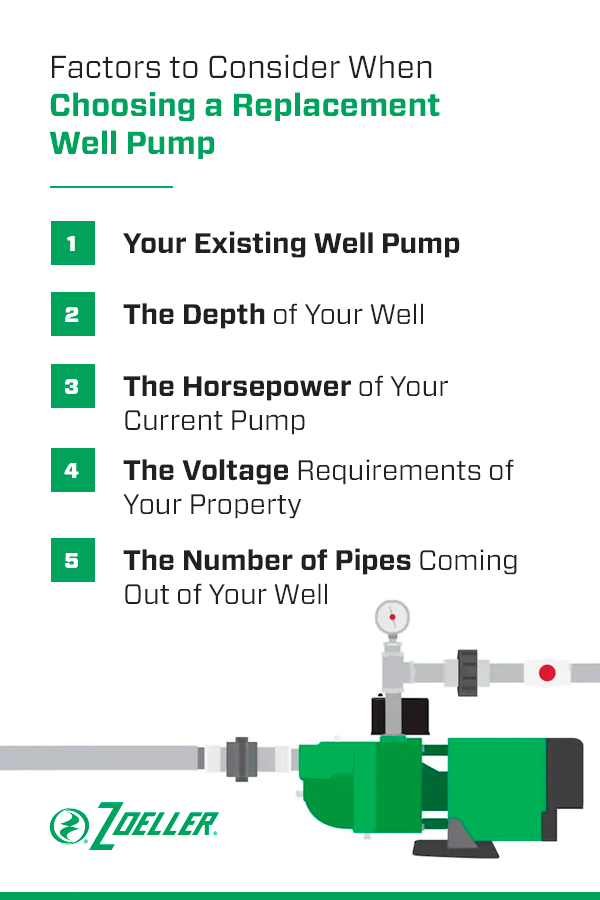
How to Choose a Replacement Well Pump
If your old well pump has suffered from wear and tear or motor burnout, think about these features to help you decide on a brand-new unit for your application:
1. Your Existing Well Pump
The most convenient and efficient way to select the best pump for your property is to replace it with the same model you already have. Since you know a shallow jet pump can accommodate your well’s depth and water pressure, you may want to buy another jet pump with better quality.
However, instead of replacing your pump with the same model, keep in mind that manufacturers have developed new models that feature better, more efficient technology, so you may want to consider upgrading. However, some older homes can’t accommodate newer pump models, so you should check the performance chart and think about the other factors before making your decision.
2. The Depth of Your Well
Consider how deep you’re pulling water from underground to determine which well pump you need. As you browse for the appropriate well pump, check the packaging for the performance chart to make sure the product can accommodate your well’s depth.
If you don’t know how deep your well is, you can take a fishing line or piece of string with a weight at the bottom and lower it until you no longer feel the weight. This change indicates that the sinker is floating in the water instead of sustaining the force of gravity. Mark where the string meets ground level, pull it out of the well and measure the line so that you know the depth of the water.
3. The Horsepower of Your Current Pump
Besides the pump’s well-depth ability, the performance chart will also include the unit’s specifications, such as its horsepower. Generally, the more horsepower your pump has, the deeper it can go underground. More horsepower also increases pressure, allowing you to have a consistent water flow for each fixture of your home, farm or field.
Try to find a replacement pump that has a similar or higher horsepower than your existing unit. You might need more horsepower for your application if you have an additional person living in the house or you’ve installed a new appliance or fixture.
4. The Voltage Requirements of Your Property
Jet pumps run on electrical power by connecting to the circuit breaker of your home. They’re typically dual voltage, and you can either set them for 230 volts or 115 volts to accommodate your property’s electrical requirements. Find out the required voltage by checking the breaker box and locating your pump’s control. A dual switch is 230 volt, and a single one is 115 volt.
5. The Number of Pipes Coming Out of Your Well
It may help to inspect how many pipes are outside of your well to figure out the water depth. You can look at your existing well pump to see how many lines connect to it. A shallow jet pump that can accommodate well depths of 0 to 25 feet has one pipe coming out of it, but a convertible jet pump for wells 26 to 110 feet deep attaches to two.
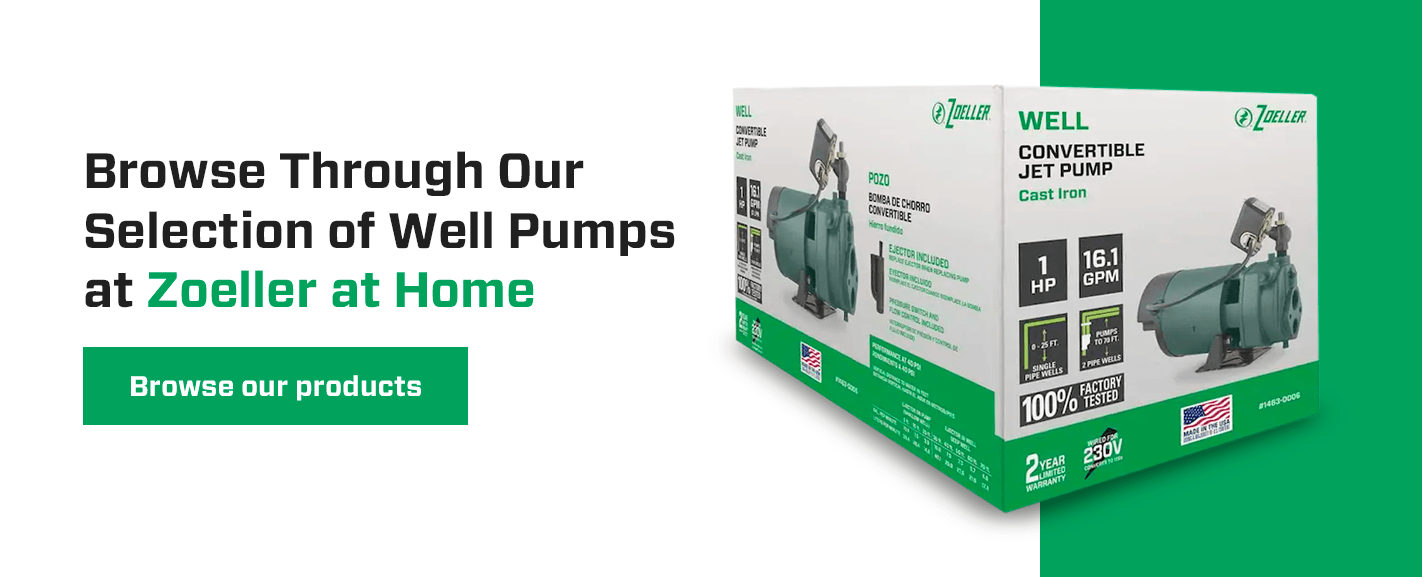
Browse Through Our Selection of Well Pumps at Zoeller at Home
If you’re ready to buy a replacement pompe de puits for your property, you can compare the features of our various products in our inventory. Trouvez un détaillant près de chez vous to get your desired unit in person. For more information about finding the right pump for your application, contactez-nous en ligne and speak with one of our representatives.
Page mise à jour le : 15 avril 2021
 Achetez maintenant chez Lowe's
Achetez maintenant chez Lowe's